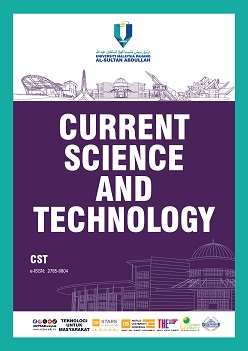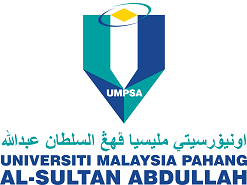Whole-Genome Sequencing of Penicillium georgiense, a Member of the Family Trichocomaceae Isolated from Harumanis Mango (Mangifera Indica L.)
DOI:
https://doi.org/10.15282/cst.v3i2.11741Keywords:
Fruit microbiome, Whole genome sequencing, Gene prediction, Harumanis mangoAbstract
Microbial communities are present in various environments, influencing their hosts through both advantageous and pathogenic interactions. The advent of next-generation sequencing technologies has enabled more comprehensive exploration of these complex communities. Penicillium georgiense (P. georgiense), a known pathogenic fungus, has been shown to cause significant spoilage through rapid colonization enabled by spore production, particularly affecting long-term storage. Contamination by Penicillium species poses risks to crops health, emphasizing the need for effective post-harvest management. In this study, Harumanis mango, widely consumed in Asia, especially in Malaysia, was selected as the model host. A single colony of P. georgiense was isolated, and their genomic DNA was extracted. The genome of the P. georgiense H_A strain was sequenced using the Illumina NovaSeq 6000 platform with short-read technology, revealing a genome size of 18,324,307 base pairs and a GC content of 46.2%. BUSCO analysis indicated 98% genome completeness, with high similarity to the P. georgiense SRG7 isolate. The annotated genome has been deposited in the NCBI GenBank database for accessibility. This study provides important genomic insights into P. georgiense, advancing our understanding of its pathogenic mechanisms and offering valuable data for improved post-harvest management of Harumanis mango.
References
[1] H. F. Ahmad, L. Schreiber, I. P. G. Marshall, P. J. Andersen, J. L. Castro-Mejía, and D. S. Nielsen, “Draft genome sequence of streptococcus anginosus strain CALM001, isolated from the gut of an elderly dane,” Microbiology Resource Announcements, vol. 8, no. 24, p. e00379-19, 2021.
[2] J. C. Royer, K. T. Madden, T. C. Norman, and K. F. LoBuglio, “Penicillium Genomics,” in Fungal Genomics, D. K. Arora and G. G. B. T.-A. M. and B. Khachatourians, Eds. Elsevier, vol. 4, pp. 285–293, 2004.
[3] D. D. Tay, S. W. Siew, S. Shamzir Kamal, M. N. Razali, and H. F. Ahmad, “ITS1 amplicon sequencing of feline gut mycobiome of Malaysian local breeds using Nanopore Flongle,” Archives of Microbiology, vol. 204, no. 6, p. 314, 2022.
[4] M. Kumar, Poonam, S. Ahmad, and R. P. Singh, “Plant growth promoting microbes: Diverse roles for sustainable and ecofriendly agriculture,” Energy Nexus, vol. 7, p. 100133, 2022.
[5] T. I. Ekwomadu and M. Mwanza, “Fusarium fungi pathogens, identification, adverse effects, disease management, and global food security: A review of the latest research,” Agriculture, vol. 13, no. 9, p. 1810, 2023.
[6] T. L. Yee and L. Zakaria, “The first report of Penicillium georgiense in Malaysia,” Mycobiology, vol. 42, no. 3, pp. 274–278, 2014.
[7] J. Y. Oh, G. D. Han, J.-J. Jeong, M. K. Sang, S.-C. Chun, and K. D. Kim, “First report of Penicillium georgiense as a fungal pathogen of onion (Allium cepa L.),” Crop Protection, vol. 72, pp. 83–89, 2015.
[8] D. Solairaj, N. N. Guillaume Legrand, Q. Yang, and H. Zhang, “Isolation of pathogenic fungi causing postharvest decay in table grapes and in vivo biocontrol activity of selected yeasts against them,” Physiological and Molecular Plant Pathology, vol. 110, p. 101478, 2020.
[9] S. M. Musa, S. S. Kamal, D. S. Nielsen, and H. F. Ahmad, “Preliminary screening of bacterial and fungal communities from spontaneous fermentation of Durian pulps (tempoyak) using high-throughput amplicon sequencing,” AIP Conference Proceedings, vol. 2682, no. 1, p. 50010, 2023.
[10] M. S. Munirah, S. S. Wei, T. D. Dean, and A. H. Fauzan, “Near-complete whole-genome sequence of paenibacillus sp. nov. strain J5C2022, a sucretolerant and endospore-forming bacterium isolated from highly concentrated sugar brine,” Microbiology Resource Announcements, vol. 12, no. 4, pp. e01055-22, 2023.
[11] R. N. Tharanathan, H. M. Yashoda, and T. N. Prabha, “Mango (Mangifera indica L.), “The king of fruits”—An overview,” Food Reviews International, vol. 22, no. 2, pp. 95-123, 2006.
[12] S. N. A. Yusuf, A. M. A. Rahman, Z. Zakaria, V. K. Subbiah, M. J. Masnan, and Z. Wahab, “Morphological variability identification of Harumanis mango (Mangifera indica L.) harvested from different location and tree age,” Tropical Life Sciences Research, vol. 31, no. 2, p. 107, 2020.
[13] T. D. Le, T. Viet Nguyen, N. Van Muoi, H. T. Toan, N. M. Lan, and T. N. Pham, “Supply chain management of Mango (Mangifera indica L.) fruit: A review with a focus on product quality during postharvest,” Frontiers in Sustainable Food Systems, vol. 5, p. 799431, 2022.
[14] N. H. Mat-Hussin, S. W. Siew, M. N. Maghpor, H. M. Gan, and H. F. Ahmad, “Method for detection of pathogenic bacteria from indoor air microbiome samples using high-throughput amplicon sequencing,” MethodsX, vol. 12, p. 102636, 2024.
[15] S. W. Siew, M. H. F. Khairi, N. A. Hamid, M. F. F. Asras, and H. F. Ahmad, “Shallow shotgun sequencing of healthcare waste reveals plastic-eating bacteria with broad-spectrum antibiotic resistance genes,” Environmental Pollution, vol. 364, p. 125330, 2025.
[16] M. Y. Choo, S. W. Siew, N. S.-A. Abdullah, M. A. N. Muhammad, and H. F. Ahmad, “Complete whole genome sequencing of Vibrio parahaemolyticus strain UMP001VA, isolated from sea cucumber Holothuria leucospilota from Malaysia harbouring blaCARB-33 gene,” Materials Today: Proceedings, vol. 75, pp. 68–73, 2023.
[17] S. W. Siew, S. M. Musa, N. ‘Azyyati Sabri, M. F. Farida Asras, and H. F. Ahmad, “Evaluation of pre-treated healthcare wastes during COVID-19 pandemic reveals pathogenic microbiota, antibiotics residues, and antibiotic resistance genes against beta-lactams,” Environmental Research, vol. 219, p. 115139, 2023.
[18] S. W. Siew, C. M. Yen, I. P. G. Marshall, H. Abd Hamid, S. S. Kamal, D. S. Nielsen et al., “Gut microbiome and metabolome of sea cucumber (Stichopus ocellatus) as putative markers for monitoring the marine sediment pollution in Pahang, Malaysia,” Marine Pollution Bulletin, vol. 182, p. 114022, 2022.
[19] A. Yunus, N. M. Mokhtar, R. A. Raja Ali, S. M. Ahmad Kendong, and H. F. Ahmad, “Methods for identification of the opportunistic gut mycobiome from colorectal adenocarcinoma biopsy tissues,” MethodsX, vol. 12, p. 102623, 2024.
[20] H. F. Ahmad, J. L. Castro Mejia, L. Krych, B. Khakimov, W. Kot, R. L. Bechshøft et al., “Gut mycobiome dysbiosis is linked to hypertriglyceridemia among home dwelling elderly danes,” bioRxiv, p. 2020-04, 2020.
[21] Z. U. Afeera, N. Kamarudin, A. H. Zulkifly, H. M. Gan, D. D. Tay, S. W. Siew et al., “Near-complete genome sequences of nine SARS-CoV-2 strains harboring the D614G mutation in Malaysia,” Microbiology Resource Announcements, vol. 10, no. 31, p. 10-1128, 2021.
[22] U. A. Zainulabid, A. S. Mat Yassim, M. Hussain, A. Aslam, S. N. Soffian, M. S. Mohd Ibrahim et al., “Whole genome sequence analysis showing unique SARS-CoV-2 lineages of B.1.524 and AU.2 in Malaysia,” PLoS One, vol. 17, no. 2, p. e0263678, 2022.
[23] A. S. M. Yassim, M. F. F. Asras, A. M. Gazali, M. S. Marcial-Coba, U. A. Zainulabid and H. F. Ahmad, “COVID-19 outbreak in Malaysia: Decoding D614G mutation of SARS-CoV-2 virus isolated from an asymptomatic case in Pahang,” Materials Today: Proceedings, vol. 48, pp. 828-836, 2021.
[24] Z. U. Afeera, S. S. Wei, M. S. Munirah, S. S. Nellisa, P. Petrick, and A. H. Fauzan, “Whole-genome sequence of a stenotrophomonas maltophilia isolate from tap water in an intensive care unit,” Microbiology Resource Announcements, vol. 12, no. 2, pp. e00995-22, 2023.
[25] N. H. M. Hussin, D. D. Tay, U. A. Zainulabid, M. N. Maghpor, and H. F. Ahmad, “Harnessing next-generation sequencing to monitor unculturable pathogenic bacteria in the indoor hospital building,” The Microbe, vol. 4, p. 100163, 2024.
[26] U. A. Zainulabid, M. N. A. Azih, A. A. Fuaat, M. R. Abidin, and H. F. Ahmad, “On-site sequencing of Polyporales sp. isolated from a rare lung fungal infection using Oxford nanopore flongle,” AIP Conference Proceedings, vol. 2682, no. 1, p. 50008, 2023.
[27] T. Brettin, J. J. Davis, T. Disz, R. A. Edwards, S. Gerdes, G. J. Olsen et al., “RASTtk: A modular and extensible implementation of the RAST algorithm for building custom annotation pipelines and annotating batches of genomes,” Scientific Reports, vol. 5, no. 1, p. 8365, 2015.
[28] S. S. Pandey, “The role of iron in phytopathogenic microbe–plant interactions: Insights into virulence and host immune response,” Plants, vol. 12, no. 17, p. 3173, 2023.
[29] M. Caza and J. Kronstad, “Shared and distinct mechanisms of iron acquisition by bacterial and fungal pathogens of humans,” Frontiers in Cellular and Infection Microbiology, vol. 3, p. 80, 2013.
[30] N. Abu Bakar, S. A. Karsani, and S. A. Alias, “Fungal survival under temperature stress: a proteomic perspective,” PeerJ, vol. 8, p. e10423, 2020.
[31] E. Garbe and S. Vylkova, “Role of amino acid metabolism in the virulence of human pathogenic fungi,” Current Clinical Microbiology Reports, vol. 6, no. 3, pp. 108–119, 2019.
Downloads
Published
Issue
Section
License
Copyright (c) 2023 The Author(s)

This work is licensed under a Creative Commons Attribution-NonCommercial 4.0 International License.



